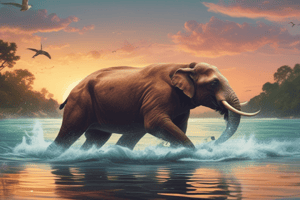Podcast
Questions and Answers
Что характеризует млекопитающих как класс позвоночных?
Что характеризует млекопитающих как класс позвоночных?
- Наличие клюва
- Наличие шерсти или меха (correct)
- Трехкамерное сердце
- Отсутствие коры головного мозга
Чем помогает четырехкамерное сердце млекопитающим?
Чем помогает четырехкамерное сердце млекопитающим?
- Эффективнее перекачивать кровь, чем у трехкамерных сердец (correct)
- Обеспечивает возможность полета
- Увеличивает скорость бега
- Снижает температуру тела
Какую функцию выполняет шерсть или мех у млекопитающих?
Какую функцию выполняет шерсть или мех у млекопитающих?
- Проведение электричества для общения
- Увеличение скорости плавания в воде
- Обеспечение полета на большие расстояния
- Изоляция от экстремальных температур, маскировка при охоте и защита от травм (correct)
Какими особенностями характеризуются млекопитающие в сравнении с другими животными?
Какими особенностями характеризуются млекопитающие в сравнении с другими животными?
Какие из перечисленных животных в тексте не относятся к млекопитающим?
Какие из перечисленных животных в тексте не относятся к млекопитающим?
Чем отличаются хищные млекопитающие (Carnivora) от грызунов (Rodentia)?
Чем отличаются хищные млекопитающие (Carnivora) от грызунов (Rodentia)?
Что делают млекопитающие в экосистеме?
Что делают млекопитающие в экосистеме?
Что означает название 'Artiodactyla' в контексте млекопитающих?
Что означает название 'Artiodactyla' в контексте млекопитающих?
В чем особенность нейрокортекса у млекопитающих?
В чем особенность нейрокортекса у млекопитающих?
Какую функцию выполняют молочные железы у млекопитающих?
Какую функцию выполняют молочные железы у млекопитающих?
Flashcards are hidden until you start studying
Study Notes
Mammals: A Diverse and Fascinating Group of Animals
Mammals form a diverse and captivating group within the animal kingdom. These creatures, distinguished by their ability to produce milk to nourish their young, encompass a wide range of species, each with unique adaptations and behaviors. Let's delve into the intriguing world of mammals, exploring their variety, characteristics, and the role they play in our ecosystems.
Defining Mammals
Mammals are a class of vertebrates, characterized by their ability to secrete milk to nourish their offspring. They are the only group of animals that do this. Mammals also exhibit other key features, such as the presence of hair or fur, a neocortex in their brains, and a four-chambered heart, which helps them pump blood more efficiently than animals with three-chambered hearts.
Types of Mammals
Mammals are categorized into several orders and families, with the most well-known mammals belonging to the mammalian orders Carnivora and Rodentia. However, mammals are diverse enough to include familiar species like primates, elephants, whales, and bats, as well as lesser-known groups like pangolins, shrews, sloths, and aardvarks.
Mammalian Adaptations
The unique characteristics of mammals have afforded them a range of adaptations that have helped them thrive in various environments.
- Hair or Fur: Provides insulation against temperature extremes, camouflage for hunting and predation, and protection against injury.
- Heart and Cardiovascular System: Four-chambered hearts improve the efficiency of blood circulation, transporting oxygen and nutrients more effectively to body tissues.
- Neocortex: Enhances problem-solving skills and allows for advanced learning capabilities.
- Mammary Glands: Enable mammals to nourish their young with milk, providing essential nutrients and antibodies to develop their immune systems.
Mammalian Classification
Mammals are classified into several orders, each with their unique characteristics:
- Carnivora: This order includes predators like lions, tigers, bears, and wolves. Carnivores have sharp teeth and claws, adapted for capturing and consuming other animals.
- Rodentia: This order is home to species like mice, rats, and squirrels, all of which have sharp, ever-growing incisors and are herbivores or omnivores. Rodents are the largest order of mammals, with over 4,000 recognized species.
- Primates: This order includes species like humans, chimpanzees, and monkeys, all of which have highly dexterous hands and feet, capable of manipulating objects and climbing trees.
- Artiodactyla: This order includes herbivores like deer, antelopes, camels, and whales. Artiodactyla means "even-toed" and refers to the hooves of these mammals, which are adapted for walking on land or swimming in water.
Importance of Mammals in Our Ecosystem
Mammals play an essential role in maintaining the balance of our ecosystems. They serve as predators, herbivores, and pollinators, contributing to various ecological processes. Mammals also offer significant economic and cultural benefits, including providing food, leather, and fur, as well as contributing to our scientific knowledge and conservation efforts.
Conservation Efforts for Mammals
Many mammal species face threats from habitat loss, poaching, and climate change. Conservation efforts aim to protect these species and their habitats, ensuring the continued existence of this diverse and fascinating group of animals.
In conclusion, mammals are unique and captivating creatures, adaptable to a wide range of environments and essential to the functioning of our ecosystems. Understanding mammals, their adaptations, and their roles in our world can inspire us to protect and conserve these incredible creatures for future generations.
Studying That Suits You
Use AI to generate personalized quizzes and flashcards to suit your learning preferences.




